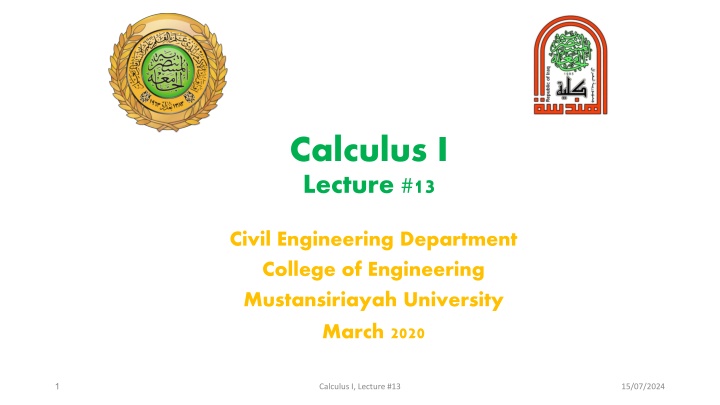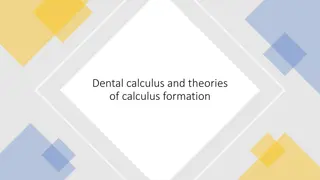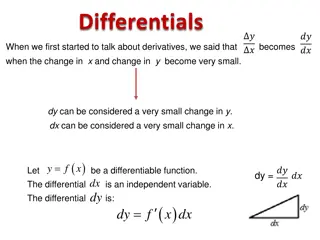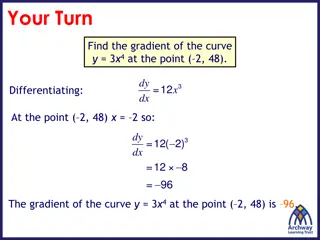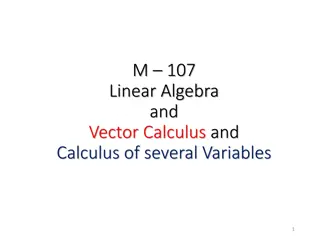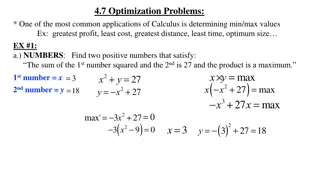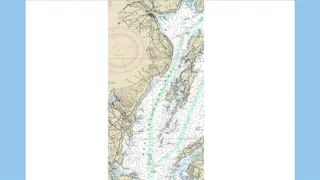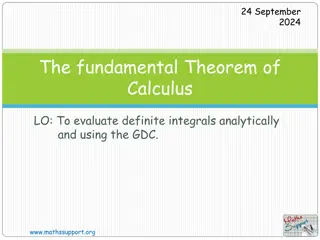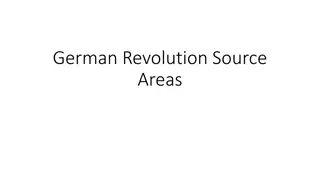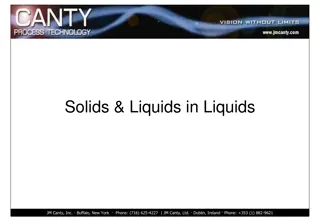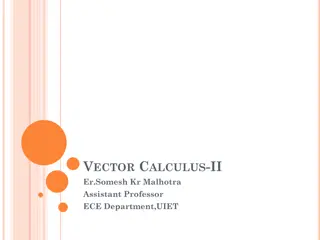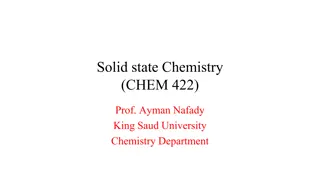Calculus I Lecture #13: Volumes of Solids and Solids of Revolution
Exploring the concepts of finding volumes of solids using integrals, by slicing solid objects with parallel planes and calculating cross-sectional areas. Examples include calculating the volume of a pyramid and a curved wedge. The method of solids of revolution using the disk method is also discussed. Visual aids and step-by-step solutions are provided for better understanding.
Download Presentation

Please find below an Image/Link to download the presentation.
The content on the website is provided AS IS for your information and personal use only. It may not be sold, licensed, or shared on other websites without obtaining consent from the author.If you encounter any issues during the download, it is possible that the publisher has removed the file from their server.
You are allowed to download the files provided on this website for personal or commercial use, subject to the condition that they are used lawfully. All files are the property of their respective owners.
The content on the website is provided AS IS for your information and personal use only. It may not be sold, licensed, or shared on other websites without obtaining consent from the author.
E N D
Presentation Transcript
Calculus I Lecture #13 Civil Engineering Department College of Engineering Mustansiriayah University March 2020 1 Calculus I, Lecture #13 15/07/2024
Volumes Volumes Volume = area x height = ?. Slicing by Parallel Planes The volume of a solid of integrable cross-sectional area A(x) from x = a to x = b is the integral of A from a to b, ? ? = ? ? ?? ? Calculating the Volume of a Solid 1. Sketch the solid and a typical cross-section. 2. Find a formula for A(x), the area of a typical cross-section. 3. Find the limits of integration. 4. Integrate A(x) to find the volume. 2 Calculus I, Lecture #13 15/07/2024
Example Example 1 1: A pyramid 3 m high has a square base that is 3 m on a side. The cross-section of the pyramid perpendicular to the altitude x m down from the vertex is a square x m on a side. Find the volume of the pyramid. Solution: 1. A sketch. We draw the pyramid with its altitude along the x- axis and its vertex at the origin and include a typical cross- section (Figure). Note that by positioning the pyramid in this way, we have vertical cross-sections that are squares, whose areas are easy to calculate. 2. A formula for A(x). The cross-section at x is a square x meters on a side, so its area is ?(?) = ?2 3. The limits of integration. The squares lie on the planes from x = 0 to x = 3. 4. Integrate to find the volume: 3 3 3 ?3 3 ?2?? = = 9 ?3 ? = ? ? ?? = 0 0 0 3 Calculus I, Lecture #13 15/07/2024
Example Example 2 2: A curved wedge is cut from a circular cylinder of radius 3m by two planes. One plane is perpendicular to the axis of the cylinder. The second plane crosses the first plane at a 45 angle at the center of the cylinder. Find the volume of the wedge. x x2+y2=9 y x o y Solution: We draw the wedge and sketch a typical cross-section perpendicular to the x-axis (Figure above ). The base of the wedge in the figure is the semicircle with ? 0 that is cut from the circle ?2+ ?2= 9 by the 45 plane when it intersects the y-axis. For any x in the interval [0, 3], the y-values in this semi-circular base vary from ? = 9 ?2to ? = 9 ?2. The area of this cross-section: ? ? = height x width = ? (2 9 ?2 = 2? 9 ?2 4 Calculus I, Lecture #13 15/07/2024
Example Example 2 2 The rectangles run from x=0 to x=3, so we have: ? 3 2? 9 ?2?? ? = ? ? ?? = ? 0 3 2 = 0 +2 39 ?2 3 2 3 2= 18 = 39 0 5 Calculus I, Lecture #13 15/07/2024
Solids of Revolution: The Disk Method Solids of Revolution: The Disk Method The solid generated by rotating (or revolving) a planar region about an axis in its plane is called a solid of revolution. ? ? = ? radius2= ? 2 ) ?(? ? ? 2?? ) ? = ? ? ?? = ? ?(? ? ? Rotation about the x-axis Example 3: The region between the curve ? = generate a solid. Find its volume. ? ,0 ? 4, and the x-axis is revolved about the x-axis to 6 Calculus I, Lecture #13 15/07/2024
Solids of Revolution: The Disk Method Solids of Revolution: The Disk Method Solution: ? 4 ? ?(?)2?? = ?2?? ? = ? ? 0 4 4 ?2 2 = ? ? ?? = ? = 8? 0 0 7 Calculus I, Lecture #13 15/07/2024
Example Example 4 4: Volume of Sphere Volume of Sphere The circle ?2+ ?2= ?2is rotated about the x-axis to generate a sphere. Find its volume. Solution: We imagine the sphere cut into thin slices by planes perpendicular to the x-axis (Figure). The cross-sectional area at a typical point x between -a and a is: ? ? = ??2= ? ?2 ?2 ? ? ? ? ? ?2 ?2?? = ? ?2? ?3 =4 ??2?? = 3??3 ) ? = ?(? ?? = 3 ? ? ? ? 8 Calculus I, Lecture #13 15/07/2024
Rotation about a Horizontal Axis Rotation about a Horizontal Axis Example 5: Find the volume of the solid generated by revolving the region bounded by ? = and x=4 about the line y=1. ? , and the lines y=1 Solution: We draw figures showing the region, a typical radius, and the generated solid (Figure). The volume is: 4 4 4 2?? = ? 12?? = ) ? = ? ?(? ? ? ? 2 ? + 1 ?? 1 1 1 4 ?2 2 2.2 =7? 3? 3 2+ ? = ? 6 1 9 Calculus I, Lecture #13 15/07/2024
Rotation about the y Rotation about the y- -axis axis Example 6: Find the volume of the solid generated by revolving the region between the y-axis and the curve ? = 2 ?,1 ? 4 about the y-axis. Solution: 2 4 4 4 2 ? ?4 ?2?? 2?? = ) ? = ? ?(? ? ?? = 1 1 1 4 = 4? 1 3 4 = 4? = 3? ?1 10 Calculus I, Lecture #13 15/07/2024
Rotation about a Vertical Axis Rotation about a Vertical Axis Example 7: Find the volume of the solid generated by revolving the region between the parabola ? = ?2+ 1 and the line x = 3 about the line x = 3. Solution: We draw figures showing the region, a typical radius, and the generated solid (Figure). Note that the cross-sections are perpendicular to the line x = 3 and have y-coordinates from ? = 2 ?? ? = The volume is: 2 . 2 2 2?? = ? 2 ?2 2?? ) ? = ? ?(? 2 2 2 2 3?3+?5 4 4?2+ ?4?? = ? 4? 2 = ? 5 2 2 =64? 2 15 11 Calculus I, Lecture #13 15/07/2024
Exercises Exercises 1. Find the volume of solid lies between planes perpendicular to the x-axis at x = -1 and x = 1. The cross- sections perpendicular to the x-axis between these planes are squares whose bases run from the semicircle ? = 1 ?2to the semicircle ? = 1 ?2. 2. Find the volume of the solid generated by revolving the shaded region about the given axis. 3. Find the volumes of the solids generated by revolving the regions bounded by the lines and curves ? = ?2 , ? = 0, ? = 2 about the x-axis. 4. Find the volume of the solid generated by revolving the region in the first quadrant bounded above by the line ? = 2 below by the curve ? = ??? ? ??? ? , and on the left by the y-axis, about the line ? = 2 . 12 Calculus I, Lecture #13 15/07/2024
